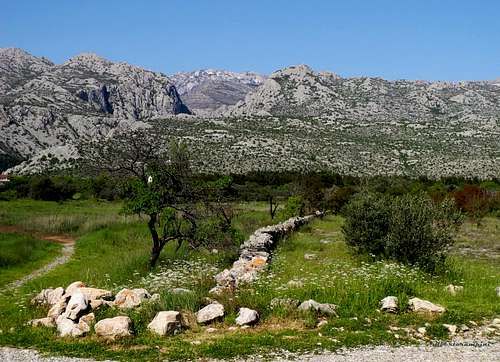-
 9916 Hits
9916 Hits
-
 87.76% Score
87.76% Score
-
 25 Votes
25 Votes
|
|
Mountain/Rock |
|---|---|
|
|
44.33794°N / 15.48038°E |
|
|
Zadar |
|
|
Trad Climbing, Sport Climbing |
|
|
Spring, Summer, Fall |
|
|
1148 ft / 350 m |
|
|
Overview
Aniča kuk Stup
The superb rocky garden of Velika Paklenica is situated in the Dinaric Alps, Velebit Group, and it’s rising from the Adriatic sea towards Vaganski 1757 m. Aniča kuk Stup is a gorgeous pillar on the right hand side of the mighty 400 m. tall NW face of Aniča kuk, the best known peak inside the impressive canyon of Velika (Great) Paklenica and surely the most grandiose of the entire region.
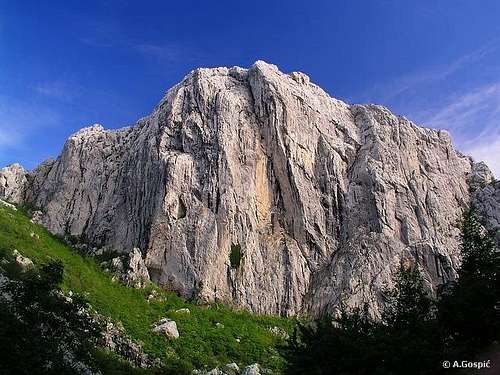
Paklenica, the most attractive climbing area in Croazia, consists of two valleys, built by an extraordinary Triassic limestone and lying in the Southern sector of Velebit, just close to the sea. The longitudinal one is running from NW to SE, while the transverse one is running from East to West, as a deep cut between the high faces of Debeli kuk and Aniča kuk. This sector is the unique part where climbing is allowed; here the climber can find routes of every kind of difficulty, engagement and length.
The main Velika Paklenica area is running side by side to the smaller canyon named Mala (Little) Paklenica, lying to the South of Velika Paklenica; here the climb is not allowed.
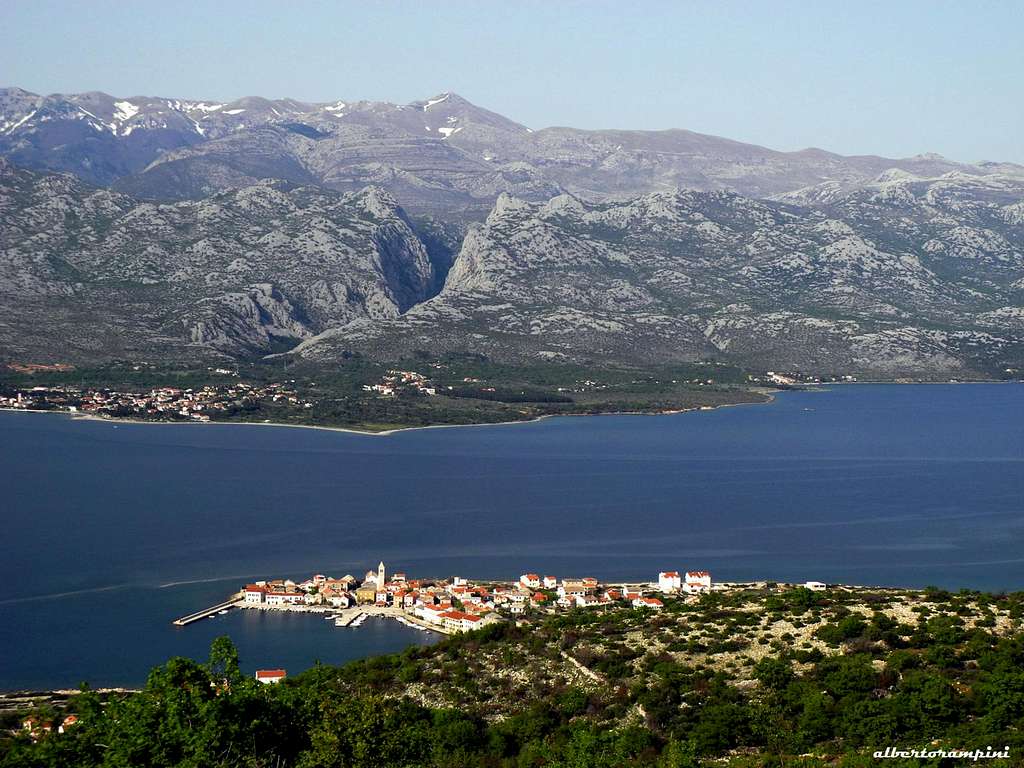
The Aniča kuk Stup is rising above the left orographic bank of Velika Paklenica creek – the right side of the gorge named Klanci - near Aniča kuk. As almost all the rocky structures in Paklenica, Aniča kuk Stup offers to the climber an excellent and charming kind of limestone, very compact and sometimes quite sharp; it has numberless routes of various difficulty, developing themselves on incredible rock formations.
Getting There
Road Approach
The canyon of Velika Paklenica can be reached very easily from Starigrad (40 km. from Zadar), a village lying on the Dalmatian coast, just at the entrance of the canyon. A narrow asphalt road is starting in Starigrad from the main coast road towards the village of Marasovici, then towards the entrance of the canyon. There are two options to get to Starigrad from Italy, Austria or Slovenia:
- the coast road starting from Rijeka and running along the Adriatic coast, shorter and panoramic but having often an intense traffic (180 km. from Rijeka to Starigrad)
- the new Motorway connecting both Rijeka and Zagreb to Starigrad via Bosilijevo, exit Maslenica (junction with the coast road), which allows to cross and see the wild and extensive forests - populated by the bear - lying in the inland. Longer but faster.
Walking Approach
From the upper parking area, lying about 2 km. besides the Park entrance, follow the large paved path running through the narrow Klanci Valley towards the Aniča Luka, the meadows at the bottom of the NW face of Aniča kuk. At the penultimate hairpin leave the main path, cross the creek (signpost) and follow on the right hand side a not obvious path rising towards the face. Before getting to the monumental face of Aniča kuk, turn to right towards Stup and skirt the pillar looking for the starting point of the various routes.
Aniča kuk Stup routes from left to right (French scale)
On Stup nowdays there is a high number of routes of various difficulty.

North West face
- Agricantus 8a (7b+/A0), 200 m. - The most impressive route of the pillar
- Desna Tržiška 6b, 120 m.
- Forma nova 6b, 100 m.
- Šaleški 5a/b – One of the most climbed routes of Aniča kuk Stup
- Trik 5a, 130 m.
West Ridge
- Brid za mali čekic’ 6c+, 120 m. - The first route in Paklenica graded higher than the VI UIAA, airy and pleasant
- Domžalski 6a, 120 - One of the most famous and climbed routes
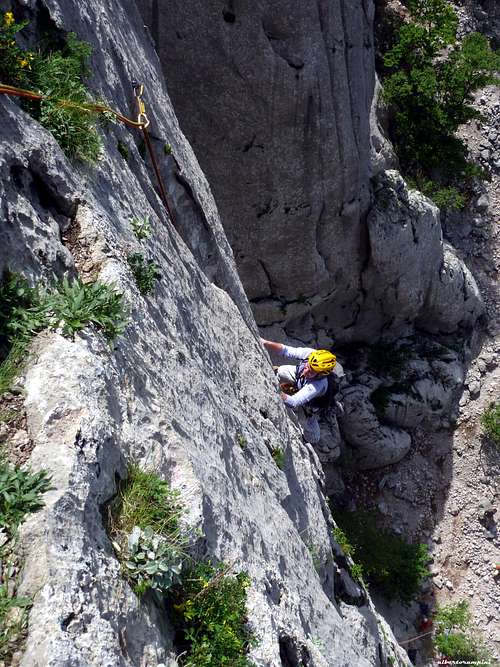
South face
- Karabore 5c, 120 – Beautiful airy route, the icon of Stup
- Walter Wolf 6c, 80 m.
- Pero 6a, 150 m. – A great climbing on beautiful steep and carved slabs
- Utopija 6a+, 100 m.
- Thuringer weg 6a, 110 m.
- Abseil pista 4b, 80 m.
- Danaja 5b, 100 m.
Descent - rappelling on the routes
History
In Paklenica rock climbing started in 1930, but unfortunately it was distressed by an accident, which caused the death of Dragutin Brahm, the Croatian pioneer who tried to climb the mighty NW face of Aniča kuk; the high number of routes nowadays existing is the result of an intense activity mainly done by Croatian, Slovenian, Italian, Austrian and Swiss climbers starting from the 60s.
About climbing and equipment of the routes
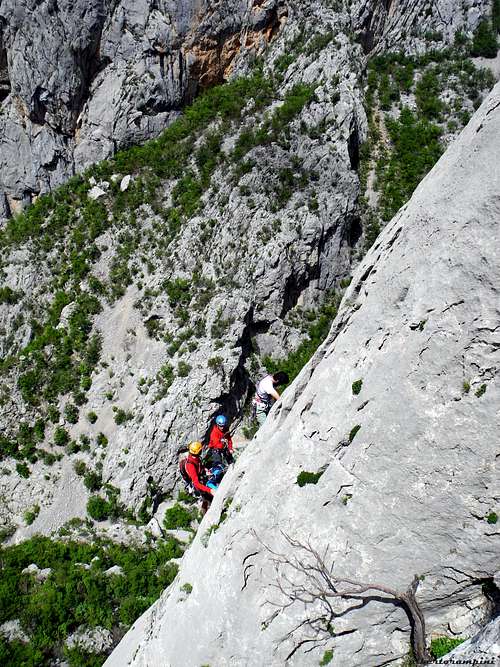
In Paklenica both realizing new routes and re-equipping old ones need a permit delivered by the National Park management; all the climbing activities are controlled by the supervisors appointed by the management. In the whole park there are innumerable routes of different difficulty and length, from the single pitch routes (mainly in the first section of the canyon, named Klanci) to the multipitch routes. The routes show different equipments: the old ones are equipped with pegs, but some of those have been re-equipped, while the recent ones are equipped with bolts. When climbing the multipitch routes, it’s always recommended to bring a set of friends, excentrics and slings.
Red Tape
Since Paklenica is characterized by a superb karst scenery with various surprising geological formations, beautiful flora and fauna and it’s also important for scientific research, on October 19th 1949 this area was declared a National Park, known as PNP - Paklenica Nacionalni Parc, one of the most important in Croatia. The whole Velebit region was proclaimed a Biogenetic Reserve by UNESCO on February 10th 1978. The access in regulated and an entrance fee is due. A 1 day, 3 days and 5 days tickets are available for climbers. Climbing is not allowed in all the smaller canyon of Mala Paklenica and in some sectors of Velika Paklenica; on the contrary hiking doesn’t’ suffer any restriction. Free camping is not allowed.
Nature and climate
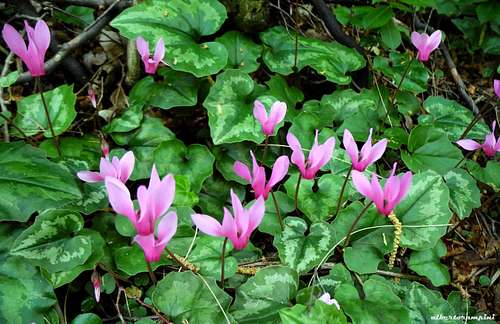

There are several differences in the climate in this region, due to the extension of the area from the higher mountains of Velebit to the lower peaks lying close to the Adriatic Sea. Continental and Mediterranean climate clash each other and PNP is particularly rich in flora (about 800 plant species, 40 of which endemic) and fauna just for this reason.
When to climb
It’s possible to climb all year round, but i personally prefer the middle seasons, the most agreeable period to climb in Paklenica (from the end of March to middle June and from September to the end of October). In summer it can be hot and it needs to climb on shady faces, but nevertheless the site is frequented by a lot of people, who wish to combine climbing with swimming. In winter the strong NE winds (the well known “bora”) can sometimes disturb the climb.
Where to stay
No problems. Starigrad Paklenica is an important touristic destination, offering several hotels, bed and breakfast and camping-sites; it’s also easy renting rooms and apartments both in Starigrad and in the close village of Seline. Don't miss a fish-dinner at Dinko (the climbers' meeting-place) ...
Meteo
Guidebooks and maps

“Paklenica“ by Boris Cujic – Editions Astroida, available in the PNP office in Starigrad (150 HRK in 2013)


